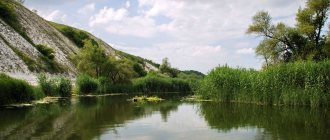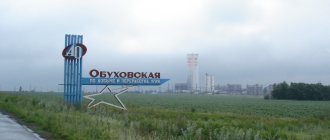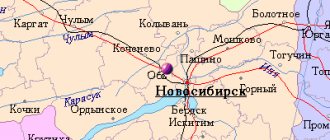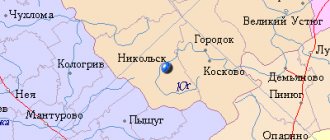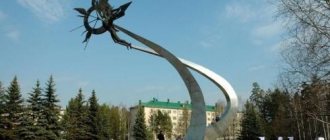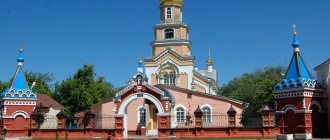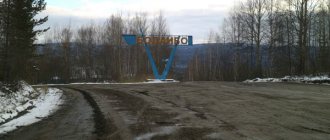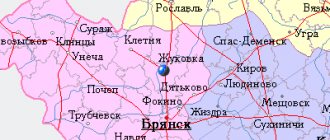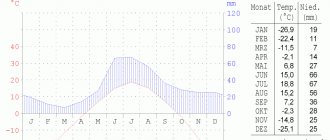Story
At the current location of the city there was an Ainu settlement of Ziancha
until 1884, when the Russian village of
Galkino-Vraskoe
(named after Mikhail Galkin-Vraskoe) was founded.
The Treaty of Portsmouth placed it under Japanese control in 1905, along with the rest of southern Sakhalin. The Japanese gave it the status of a machi
(city) called
Ochiai
.
The Red Army regained control of all of Sakhalin in 1945, during the closing stages of World War II. In 1946, the city received its current name, which roughly translates to city in the valley
.
Since the 1940s, the city's population has more than halved, from 25,135 people in 1941 to 12,200 residents recorded in the 2010 census.
References
Sources
- Sakhalin Regional Duma. Law No. 25-ZO of March 23, 2011 “On the administrative-territorial structure of the Sakhalin region,” as amended. Law No. 62-ZO of June 27, 2013 “On amendments to Article 10 of the Law of the Sakhalin Region “On the administrative-territorial structure of the Sakhalin Region””. Entered into force on April 9, 2011. Published: “Provincial Gazette”, No. 55 (3742), March 29, 2011 (Duma of the Sakhalin Region. Law No. 25-ZO of March 23, 2011 “On the administrative-territorial structure of the Sakhalin region"
as amended by the Law of June 27, 2013 No. 62-ZO "
On Amendments to Article 10 of the Law of the Sakhalin Region") On the Administrative-Territorial Structure of the Sakhalin Region"
. Valid from April 9, 2011). - Sakhalin Regional Duma. Law No. 524 of July 21, 2004 “On the borders and status of municipalities in the Sakhalin region,” as amended. Law No. 45-ZO of May 27, 2013 “On Amendments to the Law of the Sakhalin Region” On the Borders and Status of Municipal Entities in the Sakhalin Region “”. Entered into force on January 1, 2005. Published: “Provincial Gazette”, No. 175–176 (2111–2112), July 31, 2004 (Sakhalin Regional Duma. Law No. 524 of July 21, 2004 “ On the boundaries and status of municipal entities in the Sakhalin region”
, as amended by Law No. 45-ZO of May 27, 2013 “
On Amendments to the Law of the Sakhalin Region “On State Rights”).
Borders and status of municipalities in the Sakhalin region " . Effective January 1, 2005).
Priobye (Khanty-Mansi Autonomous Okrug)
Climate
- Average annual air temperature - 3.3 °C
- Average wind speed - 6.7 m/s
| Climate of Dolinsk | |||||||||||||
| Index | Jan. | Feb. | March | Apr. | May | June | July | Aug. | Sep. | Oct. | Nov. | Dec. | Year |
| Average maximum, °C | −8,4 | −6,6 | −1,3 | 6,8 | 13,8 | 19,7 | 23,1 | 23,1 | 18,3 | 10,8 | 1,3 | −6,1 | 8,0 |
| Average temperature, °C | −12,6 | −11,4 | −6,1 | 2,3 | 8,7 | 14,1 | 17,6 | 18,1 | 13,6 | 6,7 | −2 | −9,8 | 3,3 |
| Average minimum, °C | −17,2 | −16,8 | −11,5 | −2 | 3,7 | 9,1 | 12,9 | 13,7 | 9,4 | 2,9 | −5,2 | −13,5 | −1,1 |
| Precipitation rate | 62,1 | 51,5 | 59,8 | 62,1 | 81,7 | 77,6 | 88,7 | 114,9 | 119,4 | 110,2 | 95,5 | 80 | 1001,8 |
| Source: [sakhalin-meteo.ru/dolinsk/pivot/temperature Meteorological statistics for the Sakhalin region] [www.worldclimate.com/cgi-bin/grid.pl?gr=N47E142 World Climate] | |||||||||||||
City of Dolinsk, Sakhalin region
8 examples of extreme heat that claimed thousands of lives
Urban Okrug "Dolinsky" is a municipal formation in the Sakhalin region of Russia, created within the boundaries of the administrative-territorial unit of the Sakhalin region - Dolinsky district.
The administrative center is the city of Dolinsk.
The city of Dolinsk is the regional center of the Sakhalin region. The name of the city was given by the Decree of the Presidium of the Supreme Soviet of the RSFSR dated June 15, 1946. It is located in the Susunai Valley at the confluence of three rivers - Dolinka, Bolshoi Takoya and Naiba (the Ainu name of the river is Naibuchi).
The history of the city begins with the founding of the military post of Naibuchi in 1867, at the mouth of the Naiba River near two Ainu villages of Sianchi (sometimes called Siyantsi) and Otakoe (now called Takoe). During the time of Chekhov, the village of Galkino-Vrasskoye (named after the head of the Main Prison Directorate) was part of the Korsakov District. In the place where the village of Sianchi was located, the city is located today.
According to the First All-Russian Census, in 1897 115 people already lived here. There were 53 farms in the village, with 115 different buildings. Agricultural land included 18 acres of estate land and 62 acres of arable land.
In 1911, a railway was built from Toyohara (Yuzhno-Sakhalinsk) to the north, which passed through Ochiai. In 1915, 250 people lived in the village, and after the construction of a paper mill, the population increased sharply and amounted to several thousand people.
Since 1922, Otiai has become a city of regional significance. Construction of the railway north to Terpeniya Bay continues, and highways are being laid. Coal and paper industries are being created. The population of Ochiai in 1927 was 10,639 people.
In the period from 1905 to 1945 the city was part of Japan. Until 1946 it was called Otiai. The name may be from the Japanese ochi "valley, dell", which seems to be due to its location in a valley.
Since 1945, again part of Russia (USSR).
In 1956, the dairy plant came into operation, almost all production processes at the plant were mechanized. The production of a wide range of dairy products was mastered, including the production of cream, sour cream and cottage cheese, kefir, curdled milk, cheese curds and several types of ice cream.
By 1957, five settlements in the region were radio-connected; in 1956, 3,330 radio points and 2,100 receivers were registered.
In 1966, a new bread store “Kolobok” and a cafe were opened in the city, a number of stores were overhauled and re-equipped. In the same year, at the exhibition and sale of products held in Yuzhno-Sakhalinsk, products produced by meat processing plants in the regional center, Korsakov, Makarov and Dolinsk were also presented. Dolinskoye beer of the Zhigulevskoye brand was recognized by experts as the best. Soft drinks, produced in Dolinsk in a very rich assortment, were also in great demand.
The arboretum of the Sakhalin Forest Research Station located in the city has collected and presented 170 species of tree and shrub plants of the Sakhalin region. The forest is a continuation of the green zone of the city.
In past years, the pulp and paper industry occupied a leading place in the city's economy. The Dolinsky plant was one of the largest paper factories in the USSR and produced various types of paper for the whole country. However, today the plant is closed, only the boiler room remains, which heats the city in winter. The factory building was present on the Soviet coat of arms of Dolinsk (it was no longer included in the new coat of arms of the pulp and paper mill).
Since January 1, 2005, the Dolinsky district has been given the status of the municipal district of the Dolinsky urban district, consisting of the following settlements: the city of Dolinsk and 13 villages: Arsentyevka, Bykov, Vzmorye, Oktyabrskoye, Pokrovka, Ruchi, Sovetskoye, Sokol, Sosnovka, Starodubskoye, Uglezavodsk and Firsovo.
The population of the Russian Federation by municipalities as of January 1, 2022 is 11,751 people.
The coat of arms was approved on April 26, 2002. It depicts a green-azure field beveled on the left with a silver scaly thread. In a green field are three silver lilies on stems with leaves (two on the right, one on the left), accompanied at the top left by a silver band; in an azure field there is a silver eagle facing to the right with raised wings, holding a golden fish in its claws with its head to the left.
The flag was approved on February 27, 2006 as the flag of the municipal formation “Dolinsky District”. Compiled on the basis of the coat of arms according to the rules and relevant traditions of heraldry and reflects historical, cultural, socio-economic, national and other local traditions.
Notes
- ↑ 123
www.gks.ru/free_doc/doc_2016/bul_dr/mun_obr2016.rar Population of the Russian Federation by municipalities as of January 1, 2016 - [www.russianpost.ru/PostOfficeFindInterface/FindOPSByPostOfficeID.aspx?index=694051 Information about the post office on the Russian Post website]
- [dolinsk-sakh.narod.ru/index.html Website of the city of Dolinsk]
- [www.dolinsksite.ru/history History of the Municipal Municipality "Dolinsky"]. 2011-01-13
. Administration of the municipal district "Dolinsky". Retrieved June 30, 2012. [www.webcitation.org/69gM8E9IO Archived from the original on August 5, 2012]. - [dolinsk-sakh.narod.ru/geo-dolinsk.html city of Dolinsk]. Website of the city of Dolinsk (April 1, 2010). Retrieved October 24, 2014. [www.webcitation.org/68f5rvbZ8 Archived from the original on June 24, 2012].
- Administration of the governorate of Karafuto.
[kindai.ndl.go.jp/info:ndljp/pid/975896 1925 Census Results: Households and Population]. - Toyohara, 1926. - pp. 18-27. — 30 s. - Administration of the governorate of Karafuto.
[kindai.ndl.go.jp/info:ndljp/pid/1462110 1935 Census Results: Households and Population]. - Toyohara, 1936. - pp. 15-19. — 25 s. - [demoscope.ru/weekly/ssp/rus59_reg2.php All-Union Population Census of 1959. The size of the urban population of the RSFSR, its territorial units, urban settlements and urban areas by gender] (Russian). Demoscope Weekly. Retrieved September 25, 2013. [www.webcitation.org/6GDOghWC9 Archived from the original on April 28, 2013].
- ↑ 1234567891011
www.MojGorod.ru/sahalin_obl/dolinsk/index.html People's encyclopedia “My City”. Dolinsk - [demoscope.ru/weekly/ssp/rus70_reg2.php All-Union Population Census of 1970 The size of the urban population of the RSFSR, its territorial units, urban settlements and urban areas by gender.] (Russian). Demoscope Weekly. Retrieved September 25, 2013. [www.webcitation.org/6GDOiMstp Archived from the original on April 28, 2013].
- [demoscope.ru/weekly/ssp/rus79_reg2.php All-Union Population Census of 1979 The size of the urban population of the RSFSR, its territorial units, urban settlements and urban areas by gender.] (Russian). Demoscope Weekly. Retrieved September 25, 2013. [www.webcitation.org/6GDOjhZ5L Archived from the original on April 28, 2013].
- [demoscope.ru/weekly/ssp/rus89_reg2.php All-Union Population Census of 1989. Urban population]. [www.webcitation.org/617x0o0Pa Archived from the original on August 22, 2011].
- [www.perepis2002.ru/ct/doc/1_TOM_01_04.xls All-Russian Population Census 2002. Volume. 1, table 4. Population of Russia, federal districts, constituent entities of the Russian Federation, districts, urban settlements, rural settlements - regional centers and rural settlements with a population of 3 thousand or more]. [www.webcitation.org/65AdCU0q3 Archived from the original on February 3, 2012].
- [www.gks.ru/bgd/regl/B09_109/IssWWW.exe/Stg/d01/tabl-21-09.xls Number of permanent population of the Russian Federation by cities, urban-type settlements and districts as of January 1, 2009]. Retrieved January 2, 2014. [www.webcitation.org/6MJmu0z1u Archived from the original on January 2, 2014].
- [sakhalinstat.gks.ru/wps/wcm/connect/rosstat_ts/sakhalinstat/resources/b7451680420c302db621fe2d59c15b71/5.pdf All-Russian Population Census 2010. Sakhalin region. Population of urban districts, municipal districts, urban and rural settlements, urban settlements, rural settlements]. Retrieved July 28, 2014. [www.webcitation.org/6RPB9plO8 Archived from the original on July 28, 2014].
- www.gks.ru/dbscripts/munst/munst64/DBInet.cgi?pl=8112027 Sakhalin region. Estimated resident population as of January 1, 2011-2016
- [www.gks.ru/free_doc/doc_2012/bul_dr/mun_obr2012.rar Population of the Russian Federation by municipalities. Table 35. Estimated resident population as of January 1, 2012]. Retrieved May 31, 2014. [www.webcitation.org/6PyOWbdMc Archived from the original on May 31, 2014].
- [www.gks.ru/free_doc/doc_2013/bul_dr/mun_obr2013.rar Population of the Russian Federation by municipalities as of January 1, 2013. - M.: Federal State Statistics Service Rosstat, 2013. - 528 p. (Table 33. Population of urban districts, municipal districts, urban and rural settlements, urban settlements, rural settlements)]. Retrieved November 16, 2013. [www.webcitation.org/6LAdCWSxH Archived from the original on November 16, 2013].
- [www.gks.ru/free_doc/doc_2014/bul_dr/mun_obr2014.rar Table 33. Population of the Russian Federation by municipalities as of January 1, 2014]. Retrieved August 2, 2014. [www.webcitation.org/6RWqP50QK Archived from the original on August 2, 2014].
- [www.gks.ru/free_doc/doc_2015/bul_dr/mun_obr2015.rar Population of the Russian Federation by municipalities as of January 1, 2015]. Retrieved August 6, 2015. [www.webcitation.org/6aaNzOlFO Archived from the original on August 6, 2015].
- Skibina A.G.
[encsakhalin.ru/object/1804669741?lc=ru Orlov Nikolay Kozmich, doctor, Honorary Citizen of Dolinsk].
Healthcare/Personnel
. Encyclopedia of the Sakhalin region. Retrieved November 30, 2013. [www.peeep.us/8407240a Archived from the original on November 30, 2013].
24 thousand people live in the Dolinsky district
Houses for sale in the kletny area
11:34 March 20, 2022.
Natalia Volodina
Dolinsk
The results of the socio-economic development of the Dolinsky district for 2019 were summed up at an extended meeting of the mayor’s board and the main tasks for 2022 were identified. The meeting took place last Thursday at the district administration. It was attended by deputies, heads of administration departments, territorial and regional executive authorities, control and supervisory and law enforcement agencies, enterprises and organizations of all forms of ownership, as well as Deputy Minister of the Ministry of Construction of the Sakhalin Region Oleg Vodolaga.
The keynote address was made by Vice Mayor Alexey Yakuba. Alexey Fedorovich began his speech with demographic indicators. The population of the urban district as of today is 24 thousand people, of which 11,675 are urban, 12,316 are rural. Over the past few years, the number of urban residents has been increasing in the district, while the number of rural residents has been decreasing. In 2022, 303 children were born in the district, which is 37 fewer children than in 2018. The mortality rate remained at the level of the previous year and amounted to 14%, or 337 people. The level of registered unemployment remained at the level of last year - 78 people, the average monthly salary increased by 22% and amounted to 59 thousand rubles.
In the economy of the municipality, the main industries are still the fishing, food industry, agriculture, consumer market and services. For each of them, the speaker gave detailed information.
Next, the board members heard reports from the head of the financial department, Elena Igisheva, on budget execution and from the first vice-mayor, Natalya Khitsenko, on the results of the social sector.
Summing up, Deputy Minister Oleg Vodolaga wished the board members successful implementation of the assigned tasks, including continuing work on the development and implementation of programs in the field of supporting agriculture in the region, including peasant, farmer and personal, increasing the number and volume of funding for activities to support small and medium-sized businesses, intensify efforts to seize unused land plots and control the receipt of rental payments for land, and others.
At the end of the meeting, Mayor Alexander Tugarev presented a number of heads of enterprises and institutions who had made a significant contribution to the socio-economic development of the Dolinsky district with signs of gratitude and certificates of honor.
News Agency Sakh.com
- 2088
- 12
- 4
- To favorites
- Send
- Error
- Share
- Link
